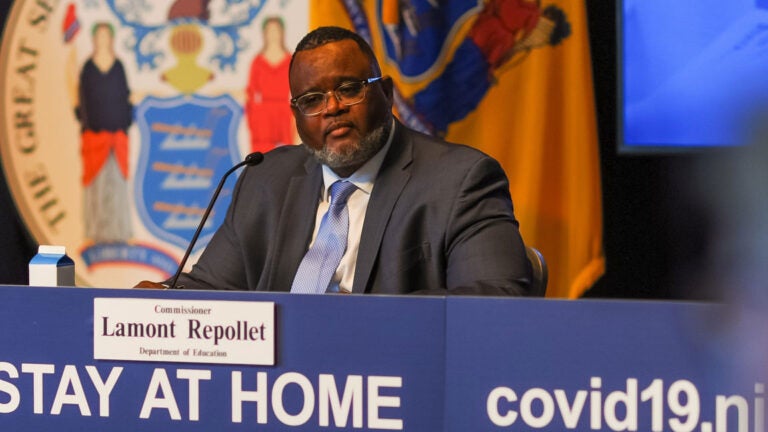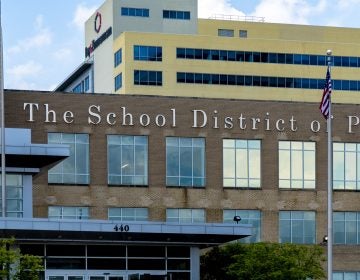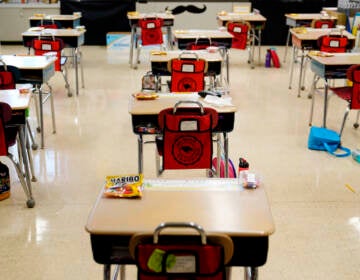Decision to close N.J. schools brings issues about remote learning to fore
Graduation, special ed, summer school — and the all-too-familiar technology gap — are just a few challenges that remain unresolved.

Commissioner Lamont Repollet speaks at a daily coronavirus press briefing. (Kevin Sanders/New Jersey Globe)
This article originally appeared on Spotlight NJ.
___
Gov. Phil Murphy’s announcement yesterday that schools would remain closed, relying on remote instruction for the rest of the academic year surprised nobody.
With the governor acknowledging New Jersey was the 46th state to do so — Ohio was the first on April 20 — it was more a matter of what took him so long.
But the long-anticipated announcement at Murphy’s daily press briefing laid bare the vast number of unresolved challenges and questions for schools, families and educators — not just in the next five weeks but in the months to come.
Here are a few of them:
How exactly is this going to work?
By most accounts, restarting schools at this point would have been a humongous logistical feat, requiring as much effort as continuing with remote instruction.
“The hurdles — logistical, educational and practical — to allow students and faculty to return even for a short while could not be overcome,” Murphy said in explaining his decision.
But that doesn’t mean anything is easy about the current situation, and Murphy and state Education Commissioner Lamont Repollet conceded as much.
“None of this we could have envisioned when we set out to be educators,” Repollet said, himself a former principal and superintendent.
But now come the hard questions. What will happen with graduations? How and will students be retained or moved ahead? How will special education and its unique challenges be addressed? And then there’s the matter of summer schools.
Repollet for the most part said more guidance was coming, leaving most of the hard decisions to individual districts. “There are different needs with different districts,” he said, repeating it several times.
Nonetheless, he said districts would be required to submit revised “emergency preparedness plans” for how the year would end and how instruction would be provided.
How graduations are handled will be left to each district, he said, with Murphy adding that he hoped for a range of “safe and creative ways to give the Class of 2020 a proper send-off.”
Grading and retention decisions would be left to districts as well, although there may be some guidance from the state, the commissioner said. And summer school viability was yet to be determined.
The yawning technology gap
Murphy said when he closed schools the first time in March that there were three main concerns: distribution of food to those in need, efficacy of remote instruction in general, and equitable access to technology for that learning.
Food for the most part is being delivered, officials said, as is remote instruction to the majority of the state’s 1.4 million schoolchildren.
But there remains a huge question mark concerning the technology needs of students, as Repollet said. The department’s own survey of 520-plus districts found 90,000 students without the needed technology at home.
When asked whether he was concerned about those numbers, Murphy acknowledged the reality: “This is not ideal. I don’t want anyone to think this is ideal.”
The districts in their revised plans will need to address those shortcomings, Repollet said, adding the state would seek $310 million in education aid under the federal CARES Act to apply to technology and other emergency needs.
“That digital divide should be lessened as we move toward September,” he said.
Repollet said districts would be left to decide how that money is to be spent. There are no guarantees the technology would be in students’ hands tomorrow, leaving students in many communities, especially poorer ones, continuing to rely on paper-and-pencil and other low-tech measures.
“School districts would be left with a great deal of discretion to how to apply these funds to address the needs of their students,” Repollet said.
Far less money to go around
Murphy didn’t mince words about the next wave of sobering news for schools and their finances: It’s going to get ugly.
When asked what should public schools expect in terms of state aid, Murphy said it’s “to be determined, but everything will get crushed.” He added that significant layoffs are to be expected across all government sectors.
“I’m more worried about manpower,” Murphy continued. “State aid has an indirect impact on manpower when it comes to our education system.”
The Education Law Center on Monday released a letter it sent to Murphy outlining the steps that districts will need to take to apply for the CARES money. With it, the ELC released estimates about how much funding would go to each district, ranging from no additional money for a handful of small districts to more than $32 million to Newark, the state’s largest.
But the funds are specifically earmarked to serve the most disadvantaged districts, especially when it comes to technology, the ELC noted.
“There is a digital divide in our state across lines of poverty, race, disability and other factors that puts students at-risk while sheltering at home,” said David Sciarra, the ELC’s executive director. “It’s time to permanently close that divide.”
And then there’s next year
School districts had already started planning for next fall’s reopening, if it’s even happening at this point. Ideas that were unheard of two months ago are suddenly real possibilities: staggered schedules, smaller class sizes, online learning and even face masks.
Again, Repollet said there would be considerable leeway offered to districts.
“Our guiding policy-principle is each local community knows its students best, and our job is to provide every flexibility we can to unlock innovation while also putting guard rails in place,” he said.
Murphy said nothing is anywhere close to decided, and a steering committee of stakeholders would be created in the coming days that would begin having those discussions.
“There is a lot to be considered to how the school day may differ once our students and faculty return,” he said.
Repollet added what is becoming all too obvious through this pandemic: “As for the future, we don’t know what it will look like.”
WHYY is your source for fact-based, in-depth journalism and information. As a nonprofit organization, we rely on financial support from readers like you. Please give today.




![CoronavirusPandemic_1024x512[1]](https://whyy.org/wp-content/uploads/2020/03/CoronavirusPandemic_1024x5121-300x150.jpg)


